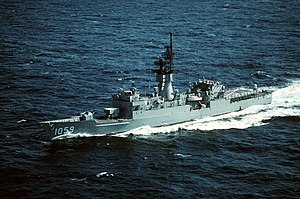USS W. S. Sims (FF-1059)

USS W. S. Sims (FF-1059)
|
|
| History | |
|---|---|
|
|
|
| Name: | USS W. S. Sims |
| Ordered: | 22 July 1964 |
| Builder: | Avondale Shipyard, Westwego, Louisiana |
| Laid down: | 10 April 1967 |
| Launched: | 4 January 1969 |
| Sponsored by: | Mrs. Robert H. Hopkins |
| Commissioned: | 3 January 1970 |
| Decommissioned: | 6 September 1991 |
| Struck: | 11 January 1995 |
| Fate: | Transferred to Turkey for spare parts 21 December 1999 |
| General characteristics | |
| Class and type: | Knox-class frigate |
| Displacement: | 3,215 tons (4,196 full load) |
| Length: | 438 ft (133.5 m) |
| Beam: | 46 ft 9 in (14.25 m) |
| Draught: | 24 ft 9 in (7.6 m) |
| Propulsion: |
|
| Speed: | over 27 knots (50 km/h) |
| Range: | 4,500 nautical miles (8,330 km) @ 20 knots (37 km/h) |
| Complement: | 18 officers, 267 enlisted |
| Sensors and processing systems: |
|
| Electronic warfare & decoys: |
AN/SLQ-32 Electronics Warfare System |
| Armament: |
|
| Aircraft carried: | one SH-2 Seasprite (LAMPS I) helicopter |
USS W. S. Sims (FF-1059) was a Knox-class frigate of the United States Navy named for William Sims. She was in commission from 1970 to 1991.
W. S. Sims was laid down on 10 April 1967, by Avondale Shipyards, Inc., Westwego, Louisiana. She was launched on 5 January 1969, sponsored by Mrs. Robert H. Hopkins (daughter of Admiral Sims), and commissioned on 3 January 1970, with C. M. Plumly in command.
Following an extended fitting-out period at the Charleston Naval Shipyard and a restricted availability at Jacksonville Shipyard for correction of minor construction faults, W. S. Sims became fully operational in June 1970, and proceeded to Guantanamo Bay, Cuba, for shakedown training. After a two and one-half month post-shakedown availability at the Charleston Naval Shipyard to correct deficiencies uncovered during shakedown and to install additional equipment, W. S. Sims was put to sea in November to evaluate the feasibility of installing the light airborne multi-purpose system (LAMPS). She was the first ship of her class to have a manned helicopter land on her deck and, during the next four days, she successfully demonstrated the capability of these new ships to operate manned helicopters. Upon completion of the testing, the escort proceeded to her home port, Mayport, Florida, for the holiday season.
On 11 January 1971, W. S. Sims left Mayport with personnel from the Key West Testing and Evaluation Detachment embarked. The project consisted of six cruises, numbered 0 to 5, where W. S. Sims operated with various types of submarines in order to determine the capabilities and limitations of the installed long range underwater sound detection equipment. The tests continued throughout the year and took the escort to such ports as New Orleans; Fredriksted, St. Croix; San Juan, Puerto Rico; and Nassau, Bahamas.
...
Wikipedia
